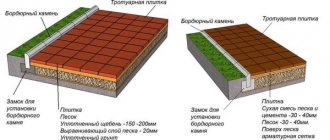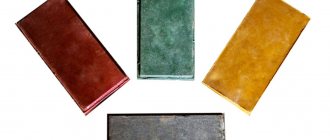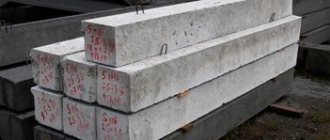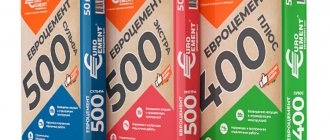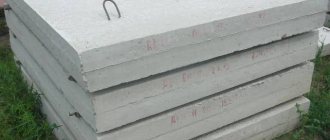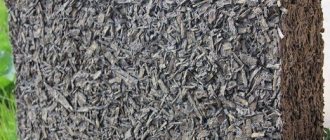Initially, when creating road surfaces, craftsmen used exclusively wild and untreated stone - with chips, sharp edges, and asymmetrical shapes. Paths lined with such stone were not comfortable, and therefore humanity gradually began to invent various methods of processing raw materials, and also came up with technologies for the production of tiles for sidewalks. We will get acquainted with modern technologies, as well as the nuances of the production of paving slabs from wild sandstone, in the following sections of the article.
Production technology
VikkaFORUMHOUSE member
Everywhere they write that vibropressed tiles are, in fact, artificial stone, they breathe and therefore withstand our weather with temperature changes much better than vibrocast tiles. I see some kind of contradiction here: after all, if there are pores and the possibility of water penetration, then the tile should crack, but here for some reason the opposite happens. Maybe it’s all from the evil one and there is no difference at all between vibro-cast and vibro-pressed tiles?
Both vibrocasting and vibropress are artificial stone produced from a mixture of cement, aggregates and water with modifying additives. But if vibration casting is 99% manual labor, and the result depends on the human factor, and products are produced at best, according to specifications, then vibration pressing is an automated process. And it is fully regulated by GOST 17608-2017 “Concrete paving slabs”. Both types of tiles are characterized by a certain permeability, but there is a difference and it is due to the peculiarities of the technological cycle.
Ilya LednevTechnical specialist of TD BRAER LLC
Vibratory casting slabs are produced by pouring a liquid solution of cement and sand into molds, followed by processing on a vibrating table. During the hardening process, this product forms a large number of pores, and the tile will have high water absorption rates, as a result, low frost resistance and strength. With vibrocompression technology, due to press pressure, it is possible to achieve a high degree of compaction of the semi-dry concrete mixture, which significantly increases the strength and frost resistance of the products. It is these indicators that determine the durability and resistance of the slabs to negative environmental influences. Thus, despite the fact that vibration-pressed tiles also “breathe,” they will last longer than vibration-molded products.
Vibrating casting is a method of making tiles that is available even at home; portal participants assemble vibrating tables without much difficulty. The differences between homemade vibro-cast tiles, which the owner of the site makes for his own needs, and tiles produced by a certain individual entrepreneur, will only be in volume. At the same time, the quality of the products in the first case may be even higher, because when making for themselves, they try to follow the recipe and adhere to the technology. Whereas in the second option, the temptation to save on raw materials and speed up the pace of work is too great in order to realize as much as possible during the season. And violations lead to far from rosy consequences.
pdpFORUMHOUSE Member
Two years ago I laid the tiles, they all crumbled into dust, they need to be redone. It was purchased from some private manufacturer. Tell me what tile to buy so that this doesn’t happen again, there is a technical nuance - you need a thin one.
Ilya Lednev
To prevent a recurrence of this problem, it is necessary to purchase paving slabs from large and reliable manufacturers. I advise you to pay attention to concrete paving slabs made using double vibrocompression technology. The product consists of two layers: the upper front and the lower main. The front layer has a decorative function and is distinguished by a variety of colors. At the same time, this technology makes it possible to use fillers of large fractions in the lower (bearing) layer and thereby improve the strength and frost resistance of products. A large selection of colors and formats of paving slabs, made using double vibrocompression technology, allows you to purchase not only durable, but also presentable paving material, including a small thickness of 40 mm.
Unlike vibro-cast paving slabs, vibro-compressed slabs are produced only by large specialized enterprises, since affording such a high-tech production line is not something that small, even medium-sized businesses simply cannot afford. And full automation of production means strict control of each stage, from the preparation of components to the acceptance of finished products.
Selection of the basic ratio of components
When producing paving slabs on your own, it is best to move away from the classical scheme. So, if you increase the mobility of the mixture, you can reduce the intensity of vibration, which greatly simplifies the manufacture of products at home. With this approach, the composition of concrete should be slightly modified.
The main proportions of concrete used for pouring paving slabs can be represented in the following diagram:
- 1 mass part of cement;
- 1.5 – 1.7 parts by mass of sand;
- 2.5 – 3 mass parts of crushed stone;
- 0.35 – 0.4 parts by mass of water;
- plasticizer + pigment.
As the class of concrete increases, cement consumption increases proportionally and the proportions of aggregates decrease. As a result, the composition of the composite changes, but the artificial stone retains its dense structure and the entire set of properties.
Characteristics of vibropressed tiles
Since paving slabs are used in outdoor conditions, increased demands are placed on them. To withstand direct contact with moisture, exposure to ultraviolet radiation, temperature changes, and mechanical abrasion, the tile must be as strong, dense and wear-resistant as possible. Vibropressed products have the following technical parameters.
- Compressive strength (concrete class) – B30.
- Water absorption – up to 6%.
- Frost resistance – F200.
- Abrasion – up to 0.5 g/cm².
As for decorativeness, vibropressed tiles are often considered to be less presentable than vibrocast tiles, and previously such claims were justified. At the very beginning, when the technology for processing dry concrete mix with both a vibrator and a press simultaneously appeared, manufacturers offered a very modest number of shapes and shades. Whereas vibratory casting could boast complex figures, a glazed, attention-grabbing surface, and bright, saturated colors. But in practice, a path paved with perfectly smooth tiles in winter turns into a real quest, which not everyone can complete without falling. And the alluring “Easter” colors not only fade literally after the season, but also the durability of such products is questionable - a large amount of pigment negatively affects the properties of the mixture.
Modern vibropressed tiles are represented by different collections, differing in shape, texture, and range. From a visual point of view, the “ColorMix” color mixing technology is interesting. Such tiles are produced using the double vibrocompression method, and dyes are added to the solution for the facing layer, but are not mixed until homogeneous. The result is a multi-colored tile with smooth transitions from one shade to another. Some collections imitate natural materials, such as sandstone, granite, marble, or even tree bark or dry foliage.
Self-production
The production of sidewalk elements with your own hands must begin with preparing a place for molding and storing products. Even with high mobility of the resulting mixture, after filling the molds, they must be compacted. Submersible or homemade vibrators are suitable.
Compaction should be carried out for no more than 5–10 s, otherwise the mixture will stratify and the appearance of the pavement elements will deteriorate.
Standard recipe
When producing a composite with strength class B25, you can use the following composition per 1 m3:
- cement = 390 – 420 kg;
- sand = 700 – 750 kg;
- crushed stone = 1000 – 1050 kg;
- water = 155 – 165 kg;
- plasticizer + pigment (if desired, color the products).
Mixing technology
When mixing the components, sand is first loaded, then water with additives and cement, and lastly crushed stone. Mixing is carried out for at least 2 - 3 minutes until a homogeneous material is obtained.
Paving slabs made of concrete of this composition will have intense hardening kinetics, so it is very important to prevent moisture loss from its surface.
Application and selection of tiles
Paving slabs are used both for pedestrian areas with minimal load, such as garden paths and blind areas, and for areas with high loads, for example, parking lots and entrances. And if the shape and design of the tile is selected in accordance with the design style of the site and the preferences of the owners, then its type and thickness must correspond to the specifics of the application.
BinarFORUMHOUSE Member
Parking in the garage entrance area, I am faced with the choice of tiles - vibration-cast 30 mm, or vibration-pressed 60 mm. Both the parking lot and the blind area will be paved (they are adjacent). Which tile do you prefer?
Ilya Lednev
If we talk about the reliability and durability of the coating, then it is worth choosing vibro-pressed paving slabs. With vibrocompression technology, due to press pressure, it is possible to achieve a high degree of compaction of the concrete mixture, which significantly increases the strength, frost resistance and, as a consequence, the durability of the products. Also, given that the paving will be done in the parking area and will be subject to loads from cars, it is better to give preference to slabs with a thickness of 60 mm.
The characteristics of vibropressed tiles, which are not only high strength and minimal water absorption, but also a rough surface, also allow the material to be used for cladding entrance areas.
310373FORUMHOUSE Member
Give me some advice: the porch and steps need to be tiled. I can’t handle clinker; they don’t recommend using porcelain tiles. The choice fell on ordinary paving slabs, which one to choose? There are some contraindications, it’s worth doing this
Ilya Lednev
Concrete paving slabs are successfully used when constructing stairs at the entrance to buildings, and porches can also be finished with slabs. I advise you to pay attention to products made using double vibration pressing technology, which are characterized by high strength and frost resistance. When constructing such a structure, the minimum thickness of the slabs is at least 40 mm and the thickness of the underlying standing is 30-50 mm.
Technology for preparing the base and laying tiles
The practicality and durability of paths and other paving elements depends not only on the quality of the finishing layer, but also on compliance with the technology for preparing the base and laying the tiles. The design is influenced by several factors: soil type, groundwater level, expected loads. But if we consider a standard “pie”, it includes the following layers.
GroundworkturfFORUMHOUSE Member
... Let's look at what ensures the strength of the base for laying tiles/paving stones.
- The bottom layer of geotextile separates the soil from the fill, preventing interpenetration, and serves as an additional reinforcing layer. Proper geotextiles have a high filtration coefficient, which prevents water from accumulating in the base.
- The next layer is sand/AGS, the role of which is to protect the geotextile from mechanical damage by the sharp edges of crushed stone, as well as to increase the fill level to the design level.
- Crushed stone of fraction 20-40 in a layer of 10-15 cm creates a solid base due to the wedging effect.
- Fine crushed stone in a 5 cm layer for decluttering large crushed stone. At the base of roads/paths it is normative, since the loads are multidirectional.
- Sand, as a leveling finishing layer of 2-3 cm, must be quarry sand with a mixed mixture of fine gravel. Seeded/washed sand is not suitable, especially fine sand. Granite screenings are a good substitute for sand.
Let me clarify, if in step 3 the layer of crushed stone is 20 cm, then the base is suitable for driving/parking vehicles. With a layer of 25 cm, operational loads are at the level of category 3 roads with long-term operation. For garden paths with low operational loads (exclusively pedestrian), point 4 can be eliminated by replacing fine crushed stone with screenings or coarse quarry sand with the characteristics indicated above. With a sufficient layer of sand/screenings, a wedging effect will be achieved.
It is worth adding that in regions with severe frost heaving, EPS slabs are laid on the ground instead of geotextiles to prevent deformation phenomena.
Vibropressed paving slabs are laid on the prepared base diagonally, in the direction away from you, using the dry method, followed by compaction and backfilling of the seams with clean sifted sand. You can decide on the installation method (pattern) either independently or with the help of professionals.
Ilya Lednev
Our free service is a photo sketch of a paving project (they send us a photo of the house with the territory, we make two options for visualizing the paving).
The video contains instructions for laying paving slabs.
Required Personnel
To reliably launch production, 3-4 people will be needed. Ideally, employees should have a construction education in order to know such an important thing as the resistance of materials. Then they can be introduced into the production process much faster and efficient production of tiles can begin.
Payroll preparation
- Calculate the number of working days per month.
- Calculate the monthly salary using the formula - (salary / number of working days in a month) * number of days worked.
- If necessary, add a regional coefficient.
- Subtract personal income tax (13%) from the amount received.
At the initial stage, it is recommended to use the average wage for workers, which in the regions is 15,000–20,000 rubles. An increase in wages to a level “above average” can be made after the enterprise has paid off. It is best to form a salary from a salary and a payment for volume. When calculating, you need to take into account any defects and fines.
The salary can be made in the amount of the minimum wage. From January 1, 2022, it is 9,489 rubles.
Conclusion
Vibropressed paving slabs are a strong, durable and beautiful material for paving paths and other areas of the site. If the base preparation technology is followed, the coating will serve for years without the need for alterations. And thanks to the textured surface, it will be safe to move along the paths in any weather conditions.
On the topic you can read about borders for garden paths, as well as about options for arranging recreation areas. In the video - landscape design according to your own project.
Subscribe to our Telegram channelExclusive posts every week

